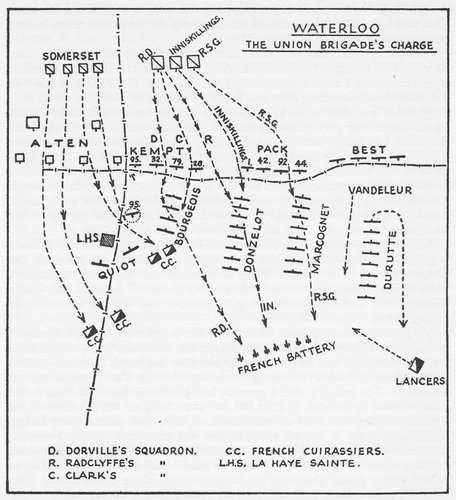
|
ISSUE NUMBER 18 |
HISTORICAL MINIATURES BY GEORGE GRASSE |
MAY 2013 |
HISTORICAL MINIATURES JOURNAL ISSUE NUMBER 18
PUBLISHED BY GEORGE GRASSE
BRITISH CAVALRY AT WATERLOO
MODELING 54mm HISTOREX KITS, Part 4: The 2nd ROYAL NORTH BRITISH DRAGOONS 'SCOTS GREYS'
SERVICE RECORD SUMMARY AT WATERLOO
The 2nd Royal North British Dragoons (RNBD), more famously know as the Scots Greys, were brigaded with the 1st Royal Dragoons and 6th Inniskilling Dragoons. The 1st Royals were often referred to as the English component in this brigade. The 6th Inniskillings were referred to as the Irish component. This brigade, the 2nd Cavalry Brigade, was known as the "Union" brigade because it represented all of Great Britain. It was commanded by Major General Sir William Ponsonby, K.C.B. The brigade's charge against the attacking infantry of Count d'Erlon's French I Army Corps at the beginning of the Battle of Waterloo disrupted three of d'Erlon's divisions and forced the temporary abandonment of French guns supporting the assault. It is regarded as one of the key elements that delayed the French attack allowing the Prussian Army to draw close enough to engage Napoleon's right flank in the afternoon.
Map of the Charge of the Union Brigade
 |
| This map is taken from Attack the Colour - The Royal Dragoons in the Peninsula and at Waterloo by A. E. Clark-Kennedy, page 101. Note how the three regiments of the Union Brigade converged on the French artillery line. Their attack was eventually disrupted with heavy casualties when the French Lancers counter-charged. |
The 2nd RNBD Scots Greys was commanded by Lt. Colonel James I. Hamilton, killed at Waterloo. The regiment had three squadrons at Waterloo with a present-for-duty strength of 31 officers and 423 other ranks, or 454 total men. It lost at Waterloo 7 officers killed and 9 wounded. Other ranks casualties were 96 killed and 89 wounded. Total loss was 198 out of 403. See table below.
| Regiment | Present | Killed | Wounded | Missing | Total | % Loss |
| 1st Royal Dragoons | 457 | 91 | 97 | 9 | 197 | 43% |
| 2nd RNBD Dragoons | 454 | 103 | 98 | 0 | 201 | 44% |
| 6th Inniskilling Dragoons | 458 | 73 | 116 | 28 | 217 | 47% |
| 2nd Cavalry Brigade Total | 1369 | 267 | 311 | 37 | 615 | 45% |
UNIFORM DESCRIBED
The standard uniform for all British Dragoons featured a red jacket topped by a brass Grecian-style helmet adorned with a falling black horse hair tail. That applies to all dragoon regiments except the Scots Greys who wore their distinctive black fur bonnet. Their lace color was yellow (gold for officers) and this applied to the cord and tassel strung around the middle of the bonnet. The front of the bonnet was decorated with a brass plate. The rear had a square brass badge. The top had a red patch which contained a galloping white horse, the symbol of the House of Hanover, the ruling dynasty of the King Georges of Great Britain.
The Scots Greys was maintained as a Royal regiment and the short-tailed red jacket was faced in royal blue (collar, cuffs, and turnbacks). The yellow lace color flowed from the top of the collar front and down the center of the jacket in two stripes on either side of the jacket opening. The center of each pair was separated by a thin line of Royal blue stitching. The waist band or girdle was yellow with two circular horizontal Royal blue stripes. The turnbacks, Royal blue, were bordered in a narrower version of the jacket's central lace. Campaign trousers were gray with a light to medium colored leather insert. A single Royal blue stripe on each outer seam was covered with white metal buttons.
Equipment was the standard issue for all British cavalry. The cartridge pouch, carbine belt, sabretache slings, and sword belt were white. The haversack was anywhere from off-white to pale gray/beige. The cartridge box and unadorned sabretache were semi-gloss black. The canteen was blue with a red-brown strap. The sword hilt and its scabbard were white metal.
MODELING A TROOPER OF THE 2nd RNBD SCOTS GREYS
|
Figure 1
|
Figure 1 - This figure is built from Historex kit HX3403 (30403), Scots Greys enlisted trooper. All of the major kit parts were cleaned of seam lines and lightly sanded with fine sand paper and primed. The legs were glued together and the torso was glued to them. I substituted the kit's head for a resin one by MIG Productions of Spain (note that the head is secured with super glue, not plastic glue). A collar had to be made from sheet lead out of my spare "lead" box. Stirrup leathers are made from strips of sheet lead attached to the kit's stirrups and glued first to the bottom of the boots and, when dry, to the inside of the legs. Figure 2 - The head is painted first followed by the collar, yellow braid down the front of the jacket, and the girdle. All of the equipment is added but each of their belts are super glued into position first. The haversack, cartridge box, and belt hardware are added to cover where the belts are joined to the body. |
Figure 2
|
| Figure
3
|
The horse starts by gluing the body halves together then the head. Modeling putty will hide the seam. While it dries, I continued on the trooper by adding the fur bonnet its details: the plume and chin scales. Painting continued with the jacket first using Vallejo VC0829 Amaranth Red. Equipment and straps were painted next. I added the sword belt with buckle and two Royal blue stripes to the yellow girdle.
|
Figure 4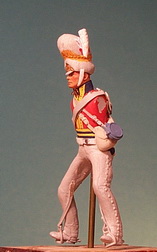 |
Figure 5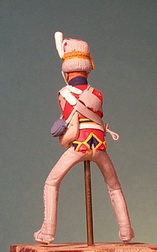 |
Figure
5, left, shows additional figure painting to the jacket turnbacks
and also shows the layout of the equipment belts. Figure 6, right, shows the horse primed to be painted after the saddle is fitted as shown. The blanket is Vallejo VC0991 Dark Sea Gray with VC0930 Dark Blue stripes. The saddle itself is Andrea ANAC42 Brown Leather washed with ANAC48 Dark Leather, later to be covered with a wash of clear semi-gloss. Note the reinforcing brass pin on the horse's left rear leg. |
Figure
6 |
|
Figure 7
|
Figure 7 - Switching back to the figure, all of the details of the fur bonnet are painted. The braided band is yellow and so are the flounders on the other side, not visible in this photo. The plume is all white, unique for the Scots Greys. Also not visible is the top of the bonnet which carried a red circular disc bearing a white galloping horse, the symbol of the House of Hanover, ruling Great Britain. Chin scales are brass. Equipment belts have their brass hardware painted. The cartridge box is plain semi-gloss black. I added the white Ordnance arrow and white "D" to the canteen. The arms were test fitted with the figure in the saddle to be sure of fit. Before they were painted and glued in place, I made gauntlet cuffs from sheet lead, glued them on, and primed them. The arms were then painted and glued to the figure when dry. The gluing was done with the figure in the saddle. The fur bonnet is fully painted and more of it is revealed in Figures 11 and 12 below. |
|
Figure 8
|
Figure 8 moves back to the horse. The scratch marks on the saddle were from placing the figure onto the horse to test fit the arms so they would not hit any of the equipment. Added to the horse at this stage was the rolled cloak at the front of the saddle, the round portmanteau (valise) at the rear of the saddle, and a small blanket roll on top. The portmanteau is trimmed in Royal blue and carries the initials "R N B D" in Royal blue. The reins and false martingale are painted in Vallejo VC0941 Burnt Umber which serves as the outline. They will be finished in medium brown. The hooves are a mix of Andrea ANAC16 Medium Brown and burnt umber. I added only two of the horseshoes to hooves that can be viewed. These were sanded to fit and painted in Vallejo VC0864 Natural Steel. |
|
|
|
Figure 9 shows the completed model. Additional trooper's equipment includes the plain two-strap black sabretache and sword scabbard. The campaign trousers had one coat of Vallejo VC0991 Dark Sea Gray previously applied. Light brown leather inserts were painted now followed by the dark blue seam stripe and brass buttons. A final coat of dark gray was applied. Boots are semi-gloss black. The visible underside of the boots was painted in Vallejo VC0875 Beige Brown. Note that the rear brass plate of the fur bonnet is just visible. The horse's reins and false martingale were made from strips of sheet lead, primed, and painted in light brown which is a mix of two-thirds Vallejo VC0981 Orange Ochre and one-third VC0913 Yellow Ochre. Harness hardware is white metal, Vallejo VC0864 Natural Steel. |
Figure 9
|
|
Figure 10
|
Figure 10 is another view of the completed figure. The carbine is glued via its attachment point to the spring-loaded hook attached to the carbine sling. The carbine wood stock is painted in Andrea ANAC17 Medium Brown and then given a coat of clear semi-gloss. At the rear of the bonnet is a brass regimental plate more clearly shown in Figures 11 and 12 below. The trooper's right hand was detached and to it was glued the sword in the position shown. Around the gauntlet is glued the sword's retention strap attached to a lead foil strip glued around the sword's guard. In this pose, the trooper is at the ready and advancing at the walk. The trooper's shoulder straps were added after the arms were glued in place. I used sheet lead to make them rather than those supplied in the kit. The lead conforms to the bulges in the belts. The straps are Royal blue edged in yellow. |
Figure 11 Figure 12
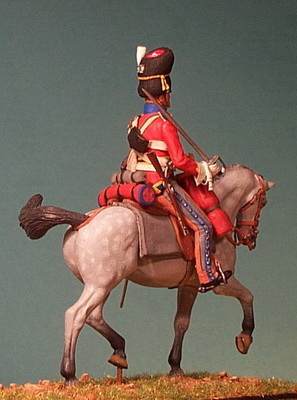
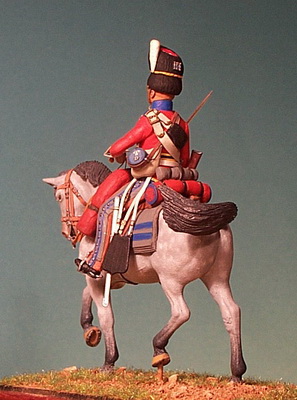
--------------------------------------------------------------------------------------------------------------
****** FINIS *******
BIBLIOGRAPHY
Bowden, Scott. Armies at Waterloo. Arlington, TX: Empire Game Press, 1983.
Clark-Kennedy, A. E. Attack the Colour! The Royal Dragoons in the Peninsula and at Waterloo. London: The Research Publishing Co., 1974.
Fosten, Brian. Wellington's Heavy Cavalry, Osprey Men-at-Arms No. 130. London, UK: Osprey Publishing Ltd., 1982.
Fosten, DSV and BK. The Thin Red Line, Plate No. 18, Cavalry of the Line - Dragoons 1815. Hackbridge, Wallington, UK: Pimpernel Studios, 1986.
Wooten, Geoffrey. Waterloo 1815 - Osprey Campaign Series No. 15. London, UK: Osprey Publishing Ltd, 1992.
GO TO?